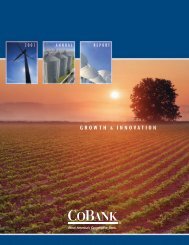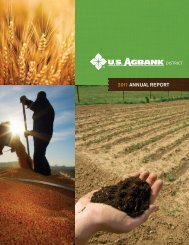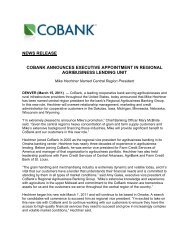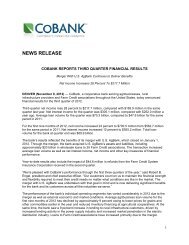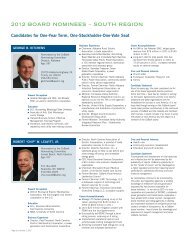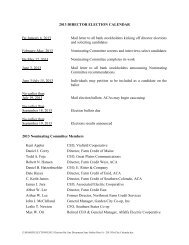We are limited to making loans and providing relatedfinancial solutions to eligible borrowers in certain specifiedindustry sectors, as mandated by the Farm Credit Act. As aresult, we have a concentration of loans to the agricultural andrural infrastructure industries. The significant risk factorsaffecting credit conditions in these industries within each ofour operating segments are described below.AgribusinessA general slowdown in the global economy and therelationship of demand for and supply of U.S. agriculturalproducts in a global marketplace can significantly impact thevolume, earnings and loan quality of our Agribusinessportfolio. In addition, changes in credit markets can affect ourability to buy and sell loans in this portfolio.The levels and price volatility of agricultural commoditiesresulting from, among other factors, seasonal weatherconditions, changes in the production levels of ethanol,financial investment in the commodity futures markets bynon-agricultural interests and changing export markets canimpact the profitability and loan quality of a significantportion of our Agribusiness customers.Major international events, including military conflicts,terrorism, political disruptions or trade agreements can affect,among other things, the price of commodities or productsused or sold by our borrowers or their access to markets. Inaddition, biological or disease risk, such as avian influenza orH1N1 virus, in human or livestock populations can impact thesupply of and demand for agricultural products.The U.S. agricultural sector receives significant financialsupport from the U.S. government through paymentsauthorized under federal legislation. While U.S. governmentsupport for agriculture has been consistent, there is noassurance that such financial support will remain at currentlevels. Although most of our customers do not generallyreceive direct payments from the federal support programs, asignificant reduction or elimination of such support wouldhave a negative impact on the loan quality of certainborrowers who derive a significant share of their earningsfrom farmers affected by such a reduction. Other political,legislative and regulatory activities may also impact the level orexistence of certain government programs.Strategic RelationshipsApproximately $15.3 billion of our total loan portfolio atDecember 31, 2009 represented direct loans to our affiliatedAssociations and participations in the direct loans of nonaffiliatedAssociations. The risk factors discussed in the“Agribusiness” section above can also impact the loan qualityof Associations and their customers. As noted previously, theloan quality of our Strategic Relationships portfolio isenhanced by our strong collateral position and the earnings,capital and reserves of the Associations that provide us abuffer from losses in their respective loan portfolios. Thecredit quality of our affiliated Associations’ loan portfolios ismore fully discussed in the Supplemental District FinancialInformation on page 88.Rural InfrastructureWe fund the construction, operations and maintenanceactivities of rural energy, communications and watercompanies. A general slowdown in the U.S. economy canreduce industrial and residential demand for services andnegatively affect customers in our Rural Infrastructureportfolio. Changes in credit markets can also impact our abilityto buy and sell loans in this portfolio.Fluctuating weather conditions can adversely affect ourcustomers in the energy industry. The pace and degree of therestructuring of the electric energy industry in the UnitedStates, including the need for additional generating capacityand the lack of open access transmission, may also impact thefuture loan quality of our energy loans. Further, futureconstraints on carbon emissions and other environmentalstandards could adversely impact customers in our energyportfolio.The communications industry is affected by significantcompetition. Regulatory, legislative and technological changesmay impact the future competitive position and markets forthe communications industry. These factors may placedownward pressure on the loan quality of certain sectors ofthe communications industry. In addition, decreased cashflows in today’s economic environment, the inability tosuccessfully integrate merged or acquired companies, or thelack of availability of debt and equity capital could adverselyaffect certain customers in our communications portfolio.Credit Quality Conditions and Measurements inOur Loan PortfolioOur loan quality declined in 2009 as the global recessioncontinued to impact certain sectors of our agribusiness andcommunications portfolios. Loans classified in the highestloan quality classification, pursuant to the FCA’s UniformLoan Classification System, decreased to 95.8 percent of thetotal loan portfolio at December 31, 2009, compared to 97.2percent at December 31, 2008. Adversely classified loans(substandard and doubtful) increased from 1.56 percent oftotal loans at December 31, 2008 to 2.17 percent atDecember 31, 2009. The following table presents loans andrelated accrued interest receivable classified pursuant to ourregulator’s Uniform Loan Classification System, as a percentof total loans and related accrued interest.Loan Quality RatiosDecember 31, 2009 2008 2007Acceptable 95.83 % 97.20 % 97.00 %Other Assets EspeciallyMentioned 2.00 1.24 1.61Substandard 2.02 1.50 1.38Doubtful 0.15 0.06 0.01Loss - - -Total 100.00 % 100.00 % 100.00 %<strong>CoBank</strong> 2009 <strong>Annual</strong> <strong>Report</strong>40
Total nonaccrual loans were $307.6 million atDecember 31, 2009 compared to $442.5 million atSeptember 30, 2009, and $217.8 million at December 31,2008. The year-over-year increase was primarily due to creditconcerns affecting a limited number of our customers in thecommunications, livestock, ethanol and dairy industries. Wesaw significant improvement in the overall level of nonaccrualloans in the fourth quarter of 2009 following the return toaccrual status of a large loan to a poultry customer that hadalso been on nonaccrual at year-end 2008. Nonaccrual loans asa percent of our total loan portfolio increased to 0.70 percentas of December 31, 2009 compared to 0.49 percent atDecember 31, 2008. Over the past 10 years, nonaccrual loanshave averaged 0.72 percent of the total loan portfolio.Net loan charge-offs totaled $65.2 million in 2009 and$18.8 million in 2008. Gross charge-offs in 2009 were $70.2million compared to $25.6 million in 2008. The increase incharge-offs was principally driven by charge-offs related to alimited number of customers in the communications and dairyindustries.Summary of High-Risk Assets ($ in Millions)December 31, 2009 2008 2007 2006 2005Nonaccrual Loans $ 308 $ 218 $ 15 $ 83 $ 120Accruing Loans 90 Days or More Past Due 15 4 2 3 -Restructured Loans - - - 1 1Total Impaired Loans 323 222 17 87 121Other Property Owned - - - 3 -Total High-Risk Assets $ 323 $ 222 $ 17 $ 90 $ 121As part of our overall assessment of risk in the loanportfolio and the reserve for credit exposure as ofDecember 31, 2009, we have considered the following factors:The global recession increased the risk of furtherdeterioration in all segments of our loan portfolio;While conditions have improved somewhat in recentmonths, stress and illiquidity in the capital marketsmay limit access to new debt and equity funding forsome participants and potentially increase defaultrisks and the effects of risk concentrations;Livestock and dairy industries have faced marginpressure and operating losses;Communications companies face stress resultingfrom weakness in the overall economy, changingtechnology and lower asset valuations;Excess production capacity and the volatility of inputcosts, coupled with potential future changes in stateprograms and subsidies, present ongoing uncertaintyin the ethanol industry; andThe weakness in the housing market is adverselyimpacting the forest products industry.We anticipate a continued modest decline in the creditquality of our loan portfolio as economic challenges continueto impact customers in a limited number of industries weserve, including communications, livestock, dairy and forestproducts.Our reserve for credit exposure represented 1.13 percentof outstanding loans as of the end of 2009, compared to 1.09percent and 1.10 percent of total loans at December 31, 2008and 2007, respectively. At December 31, 2009, our reserve forcredit exposure represented 1.98 percent of non-guaranteedloans when loans to Associations are excluded.See “Critical Accounting Estimates – Reserve for CreditExposure” on page 55 for a more complete description of ourprocess to determine the adequacy of our reserve for creditexposure.Credit Risk Related to Investments and DerivativesWe minimize credit risk in our liquidity investmentportfolio by investing only in securities that, at purchase, arerated triple-A by one or more major rating agencies. Inaddition, we invest primarily in securities issued or guaranteedby the U.S. government or one of its agencies. At year-end2009, approximately 94 percent of our investment portfolio iscomposed of securities with either an implied or explicitguarantee of the U.S. government. More specifically, 55percent of our investment portfolio consists of securities thatcarry a full faith and credit guarantee of the U.S. government.These securities include mortgage-backed securities issued bythe Government National Mortgage Association and U.S.Treasury and other debt securities. Approximately 39 percentof our investment portfolio consists of securities issued bygovernment agencies, primarily mortgage-backed securitiesissued by the Federal National Mortgage Association (FannieMae) and the Federal Home Loan Mortgage Corporation(Freddie Mac). While such investments carry the impliedbacking of the U.S. government, government actions over thepast two years to strengthen the capital of, and improve theliquidity of securities issued by, Fannie Mae and Freddie Macindicate a strengthening of the U.S. government’scommitment to the obligations of these housing GSEs. To amuch lesser extent, and largely prior to 2006, we also investedin non-agency mortgage- and asset-backed securities. Suchsecurities currently comprise approximately 6 percent of ourinvestment portfolio.<strong>CoBank</strong> 2009 <strong>Annual</strong> <strong>Report</strong>41
- Page 9 and 10: we believe CoBank iswell-positioned
- Page 11 and 12: R E G I O N A L A G R I B U S I N E
- Page 13 and 14: C O R P O R A T E A G R I B U S I N
- Page 15 and 16: S T R A T E G I C R E L A T I O N S
- Page 17 and 18: E L E C T R I C D I S T R I B U T I
- Page 19 and 20: E N E R G Y & W A T E R B A N K I N
- Page 21 and 22: E N E R G Y & W A T E R B A N K I N
- Page 23 and 24: C O M M U N I C A T I O N S B A N K
- Page 25 and 26: S T R AT E G I C R E L AT I O N S H
- Page 27 and 28: Co b a n k 2009 financial r e p ort
- Page 29 and 30: Five-Year Summary of Selected Conso
- Page 31 and 32: institutions and members of the Sys
- Page 33 and 34: Net interest income increased to $9
- Page 35 and 36: The increase in Insurance Fund prem
- Page 37 and 38: The following table presents activi
- Page 39 and 40: Noninterest income in our Agribusin
- Page 44 and 45: Prior to purchase, we assess the cr
- Page 46 and 47: Our interest rate sensitivity posit
- Page 48 and 49: We have included a summary of our d
- Page 50 and 51: Due to the often volatile funding n
- Page 52 and 53: We are Subject to Liquidity Risk wi
- Page 54 and 55: CapitalWe believe that a sound capi
- Page 56 and 57: Economic CapitalEconomic capital is
- Page 58 and 59: The degree of management judgment i
- Page 61 and 62: Consolidated Balance SheetsCoBank,
- Page 63 and 64: Consolidated Statements of Changes
- Page 65 and 66: Notes to Consolidated Financial Sta
- Page 67 and 68: CashFor purposes of these financial
- Page 69 and 70: A summary of the components of FCL
- Page 71 and 72: The following table shows the fair
- Page 73 and 74: The Insurance Fund is available to
- Page 75 and 76: Description of EquitiesIn March 200
- Page 77 and 78: The projected benefit obligation an
- Page 79 and 80: Investment strategy and objectives
- Page 81 and 82: As of December 31, 2009, the maximu
- Page 83 and 84: Estimated Fair Value of Financial I
- Page 85 and 86: To minimize the risk of credit loss
- Page 87 and 88: Segment Financial InformationStrate
- Page 89 and 90: Note 17 - Quarterly Financial Infor
- Page 91 and 92:
Supplemental District Financial Inf
- Page 93 and 94:
Supplemental District Financial Inf
- Page 95 and 96:
Report of Independent AuditorsCoBan
- Page 97 and 98:
Management’s Report on Internal C
- Page 99 and 100:
Annual Report to Shareholders Discl
- Page 101 and 102:
Board of Directors Disclosure as of
- Page 103 and 104:
Board of Directors Disclosure as of
- Page 106 and 107:
Board of Directors Disclosure as of
- Page 108 and 109:
Senior OfficersCoBank, ACBRobert B.
- Page 110 and 111:
Senior Officers Compensation Discus
- Page 112 and 113:
Senior Officers Compensation Discus
- Page 114 and 115:
Senior Officers Compensation Discus
- Page 116 and 117:
Senior Officers Compensation Discus
- Page 118 and 119:
Code of EthicsCoBank, ACBCoBank set
- Page 120 and 121:
CERTIFICATIONI, Robert B. Engel, Pr
- Page 122 and 123:
CERTIFICATIONI, David P. Burlage, S
- Page 124 and 125:
Customer PrivacyYour financial priv
- Page 126:
5 5 0 0 s o u t h Q u e b e c s t r




